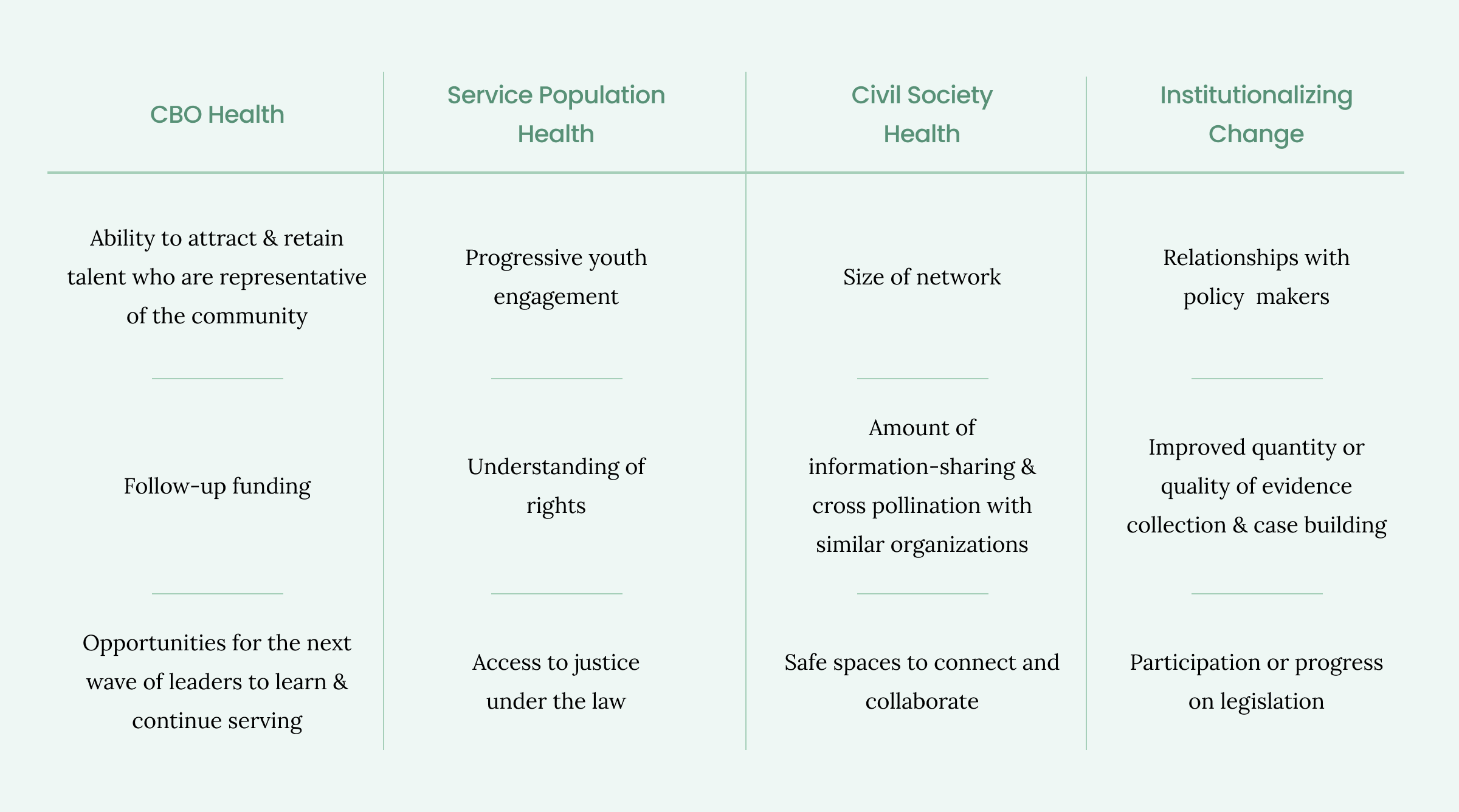Reimagining impact with communities in mind
We all want to know the answer to a pretty foundational question: are we doing good?

Impact is the huge, virtuous goal that probably brought you to grantmaking in the first place. So it makes sense that the philanthropy community talks a lot about the process of understanding and measuring impact.


The 3 elements of impact
To really understand impact and what it means on the ground, it’s helpful to break it down into three elements:
-
1
Goals
Your goals for impact should all ladder up to a broader goal: lasting change. Unfortunately, some traditional impact reporting models emphasize...
Read moreYour goals for impact should all ladder up to a broader goal: lasting change. Unfortunately, some traditional impact reporting models emphasize short-term results, even though we already know that focusing on short-term solutions isn’t effective for systemic change . It’s also common for funders to try to satisfy Western standards of growth and economic efficiency that do not always translate on the ground. Instead, root your goals in the bigger picture of real, lasting change.Toggle accordion item
Show less -
2
Metrics
What markers or milestones are you looking at to understand impact? And how does that connect back to a nonprofit’s mission? It’s really tempting...
Read moreWhat markers or milestones are you looking at to understand impact? And how does that connect back to a nonprofit’s mission? It’s really tempting to track data that is easy to grasp and easy to measure, but the round numbers that look great in an annual report (“We bought 100 computers!”) can miss the bigger goal of meaningful change. Plus, our Western inclination for quantifiable data has increasingly led funders to lean on repeatable metrics. Social change is large and porous, so the way you measure impact might be less about definitive metrics and more about monitoring and learning.Toggle accordion item
Show less -
3
Mindset
To build a partnership with a local nonprofit that is really centered in trust, your approach to impact should also start with trust. In traditional methods of philanthropy...
Read moreTo build a partnership with a local nonprofit that is really centered in trust, your approach to impact should also start with trust. In traditional methods of philanthropy, impact is most often defined by a funder. It’s about a problem they are trying to solve. This attitude shows up in measurement and reporting, with the funder determining what gets measured and how it’s delivered back to them. A common example is when an institutional funder mobilizes an entire nonprofit to use a “results tracker” system that doesn’t map to their existing programs or goals. Alternatively, a trust-based approach might begin with listening to an organization's existing goals and metrics, and supporting their own understanding of impact.Toggle accordion item
Show less
Our philosophy on impact


Social change is hard to measure.
First, we want to acknowledge that impact is a tremendously complex idea. Many local leaders are working on challenging, interconnected problems — the more important the issues, the harder they are to measure. Social movements are nebulous, ever-changing, and just don’t fit into standardized numerics. However, there are ways that funders can listen to nonprofits, refocus the process to center it in trust, and learn to assess impact in more diverse ways.
Reflect on the “why” of measurement.
Second, understanding your personal motivation for measuring impact is important. Will measuring this tangibly help the community? Why this metric? What does it tell you, what doesn’t it tell you? When you’re digging deep into your reason for measuring impact, make sure it starts and ends with supporting your nonprofit partner’s mission. Any measurement that doesn’t accomplish this goal should be revisited.
Trust local leaders to define impact.
The people closest to the problems are often closest to the solutions. That means that local leaders should determine what impact means for their own communities. When you’re deeply listening to a nonprofit’s vision, you’ll hear them tell you what their mission and goals are.
Every community has different needs and goals, and you can support a community-based organization (CBO) on their path by following their lead. Chances are they have the best insights when it comes to measuring the impact of their initiatives. In fact, the most important “success” may not be program outcomes, but the ownership and involvement of the community itself — and their ability to fail, learn, and respond. This kind of collaborative process, developed through multi-year partnerships, is part of the larger work of trust and dignity that is central to direct philanthropy.
We’ve talked to funders and CBOs that all observe the same shift when trust is part of the process. Genevieve Smith, Founder of GV Advisory, shares: “Social change is complex, and begins at the local community level. When funders trust grantees to define and report impact, our work is more equitable, sustainable, and — ultimately — impactful.”
Fund close to the root cause.
Going back to understanding impact on a systemic scale, it’s important that you choose partners who work as close as possible to the root cause of an issue. Focusing on organizations that tackle deeper challenges will be more impactful, by design, because of the ripple effects on communities. Not every initiative will work, but you can be strategic by investing in what does — you could even start with a few community initiatives and double down on the ones that meet their goals. You have the opportunity to be deliberate with your support, helping to sustain the long-term work that communities have already started.
Tactics for understanding impact
Make room for unforeseen impact.

There are really two kinds of impact: projected and unforeseen. When nonprofits work towards specific goals, many opportunities for other benefits can emerge along the way. This is another reason why flexible funding is so important — it allows organizations to shift resources to the most impactful strategies and elements of an initiative, even if that impact wasn’t anticipated.
For example, local nonprofit KAPAL facilitated the creation of women-led farming collectives in response to the COVID-19 pandemic in Indonesia. Did the farms lead to more food stability (the intended result)? Yes. And it was a huge boost in morale for the participants. But the farmers’ WhatsApp group led to another, more surprising benefit. Women started opening up about incredibly personal experiences of domestic violence — a topic that is frequently silenced by shame and fear — and shared resources to refer each other for services.
Traditional reporting structures don’t always celebrate this kind of “win,” but you have the opportunity to give weight to these unanticipated results. It could be as simple as leaving space in your learning process for documenting why something was successful: “We set out to achieve X, but in the meantime Y happened. It was successful and here’s why.”
"It is very hard to find the time to find donors. This flexible grant offer came to us, and it was such a relief. We are so grateful for that, and also for the easier reporting as larger aid organizations often require log frames and detailed reporting, making it hard to fit our data into their systems."
- Marina, Women for the World, Myanmar
Break up long-term goals into purposeful milestones.
All of your monitoring methods should support the long-term growth of your partner, and the health of the community they’re serving. Framing impact in this way will also help you refine and re-refine your strategy over time.
So, what does that mean in practice? Once a nonprofit has defined what their goals are, you can support them in finding individual milestones that ladder up to that long-term mission. Instead of short-term numbers, this might look more like considering how well local leaders are empowered to do their work. Or analyzing how an initiative lays the groundwork for bigger social changes to happen. The report Putting People First found that many small grant funds measure by looking at indicators like “whether groups are successfully enhancing the space and power to engage in constructive dialogue and improve the recognition and protection of rights.”
The network AMAN is another good example in action — they make sure their work and messaging attracts young people as a strategy for impact down the road. Director Dwi Ruby K shares: “Being progressive is important to bring young people into the work. AMAN’s work inspires younger generations who have high potential to make an impact for decades to come.” So, one indicator of impact for them might be how many young people they attract.
Milestones could be qualitative, as well as quantitative — especially when they relate to collective efforts that are critical for long-term change, but difficult to attribute to a single grant. Here are more ideas for alternative milestones, to help you visualize how they can start within an organization and grow to encompass collective efforts at institutional change.

Use the data an organization already collects.

When you’re starting a relationship with an organization, pay attention to how they learn. What are they tracking? What matters to them? Many established nonprofits already have frameworks and measuring tools in place. If so, great — that’s another wheel you don’t need to reinvent. Out of all the data they’re collecting, you can ask if they’re willing to share certain (anonymized) pieces. From there, you’ll have milestones to come back to as you learn together.
“The common assumption is you can only have rigor if you have numbers. We look at how an organization learns for itself. What are their monitoring systems? None of that data is just collected for donors — it’s how they’re really learning and growing the organization themselves. We know that our partnerships are most successful when we’re following their lead.”
- Nicky Wilkinson, Executive Director of Firetree Philanthropy
Tap into existing tools whenever you can. Use a census or other publicly available datasets to get information like demographics or income data before you embark on a brand new measurement project. Remember that all data collection is extractive by nature, and you don’t want to burden communities with the task of measurement.
Fund data collection.
Building a strong baseline of data and then tracking initiatives over time takes resources. In some cases, funders have high expectations for data systems, but are unwilling to fund the administrative costs for building them. If a local nonprofit wants to dig deep into data collection, consider supporting them! Many CBOs would love to implement a survey or track specific data in their community, but they just don’t have the time or money. Or, in other cases, they have data systems in place, but don’t have the bandwidth to focus on really using those capabilities. Consider funding long-term measurement projects that analyze nuanced milestones, like the ones mentioned above. You have the resources to provide technical support or help your partners use their existing data wisely.
“Our impact measurement approaches should reflect an investment of resources that is commensurate with the expected return. We cannot align our aspirations to a single gold standard of impact evaluation but must recognize that the design, method, and cost will vary substantially and that there will be times when not measuring impact will make the most sense.”
- Corrina Grace, Principal Consultant and Author of We, The Weavers
Use conversation to regularly check in about impact


Since one of our goals is learning, let’s transform monitoring and reporting into a collaborative process. Retrospective meetings (or “retros”, to borrow from our tech friends) can be focused on what you learned so far and how to move forward, all without overburdening local leaders with paperwork.
A retro can be pretty simple. Generally, you’re asking four questions:
1. What did you think would happen?
2. What did happen?
3. What did you learn?
4. How do we improve going forward?
Transparency and communication are key. We’ve talked to funders who facilitate these conversations over a phone call, or others who use an in-person roundtable approach. Bring a small group together, put on a pot of coffee, and ask open-ended questions. In this kind of relaxed environment, partners are more comfortable sharing unexpected results or challenges. After a retro, it’s the funder’s job to type up the notes. In the end, you all walk away with a document of what you’ve accomplished, what you learned, and where you’re going next — and you did it by listening.
Participatory learning and assessment practices offer many more ways to center a local community in the evaluation process. Learn about participatory methods with this resource from the Institute for Development Studies →
Measure your own success as a funder.
Assess your own work by getting feedback directly from grantees on what is and isn’t working. As a funder, you have the opportunity — and the responsibility — to create a space for open dialogue and mutual learning with the local leaders you support. Outside of any individual grantmaking initiatives, you should think about ways to measure your own ability to meaningfully support systemic change. What are your goals as a funder? How can you hold yourself accountable?
Possible funder milestones:
- Breadth of your philanthropic network
- Number of introductions to potential local partners
- Amount of money given
- Percentage of investment that goes to nonprofits that are led by locals
Keep listening, keep learning
This is the final piece in our Direct Philanthropy Starter Kit. We hope you found some answers, actions, and maybe even uncovered new questions. Feeling excited? Nervous? A little of both?


Sign up for our lightweight newsletter
Insights and resources for important work